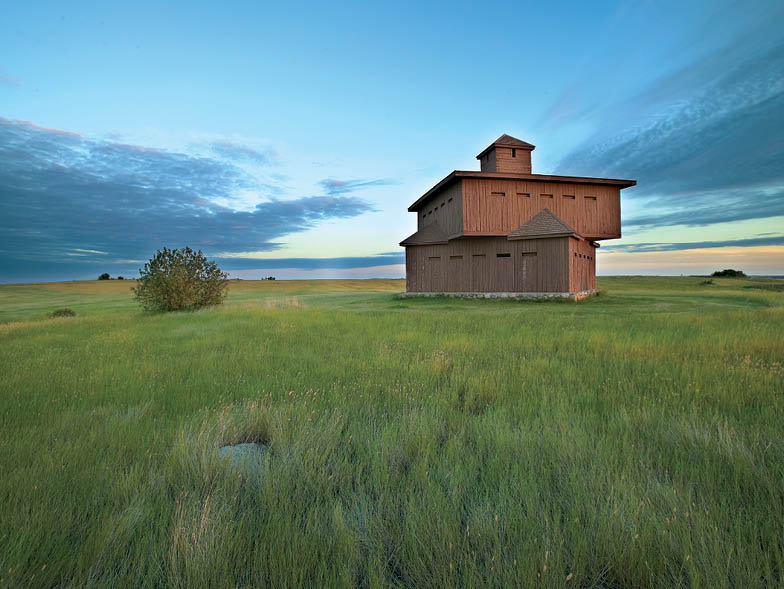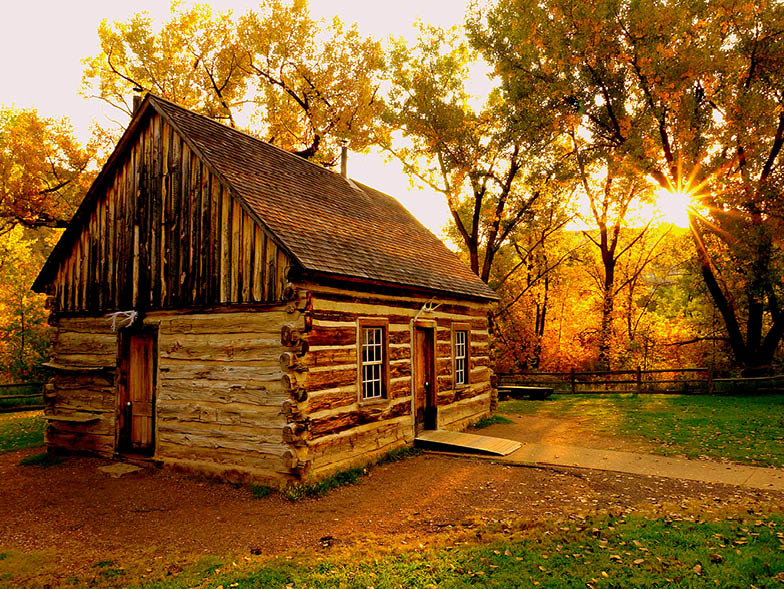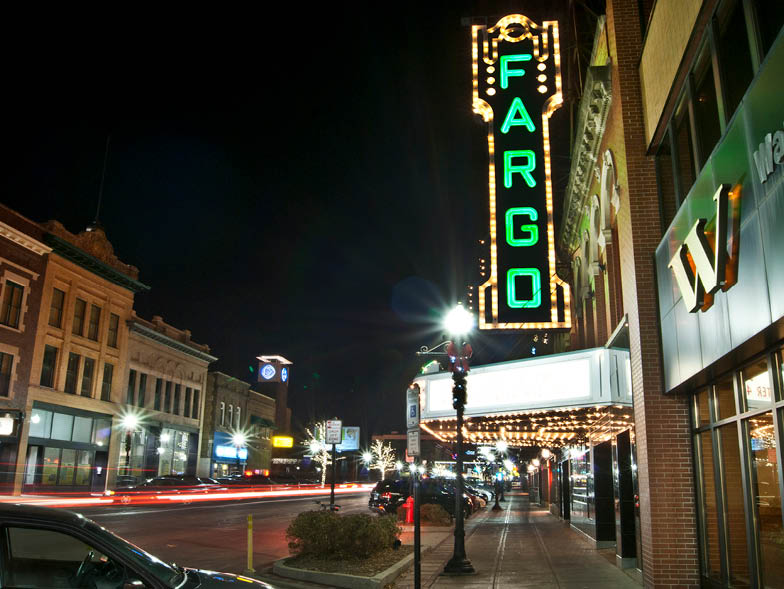Notes on North Dakota: A Trip to the Midwest
North Dakota is a beautiful and sweeping midwestern state that’s as rich in history as it is in wilderness. Today, it offers one of the country’s greatest outdoor experiences while its metropolitan areas boast fine amenities and activities, making it a unique place to behold, as writer Marnie Lahtinen discovered while traversing the thirty-ninth state.
As you drive across the open expanse of North Dakota, you feel your pulse slowing and your senses sharpening. It’s calming: the big, blue, cloud-laden sky above you, the wind whistling through your windows, and the space all around you. You feel small, yet significant, in tune with and centered in your surroundings. The road stretches before you through wheat- and flax-covered plains dotted with prairie lakes and farmhouses. You become keenly aware that you have entered a special territory, almost a modern-day last frontier.
North Dakota, located on the northern edge of America’s Great Plains, comprises over 70,000 square miles of diverse landscape, economy, and citizenry. Agronomy roots run deep here—more than 87 percent of the state is agricultural private property. Farming and ranching have been here for a long time; however, the recent energy boom in the western part of the state and the steady growth of technology and manufacturing in the east have been a boost to North Dakota’s metropolitan areas. Superb restaurants and nightlife have flourished over the last decade, and fashionable retailers have made shopping a tourist attraction in larger communities. The evolution of this prairie state from its creation in 1889 has resulted in a population today that blends modern and modest, entrepreneurs and adventure seekers, all in a setting that inspired history-makers from the beginning.

The History
The first inhabitants of what is now North Dakota arrived at the end of the last Ice Age, roughly 12,000 years ago. Nomadic hunters came in search of woolly mammoths and giant bison. Eventually, these nomadic groups coexisted with agricultural Native American tribes, including Dakota, Assiniboine, Cheyenne, Mandan, Hidatsa, and Arikara. European traders who arrived in the 1700s were impressed with the Mandan tribe’s advanced agricultural and trading society. The Lewis and Clark expedition wintered with the Mandan along the Missouri River in 1804–1805 and relied heavily on Native Americans as a source for food and trade. Lewis and Clark put what’s now called North Dakota on the map (literally), and their experiences in the state are described in detail at the Lewis and Clark Interpretive Center in Washburn. Stroll through the impressive displays to see replicas of items used by the Corps of Discovery, including Lewis’s air rifle, which is one of only six such working weapons in the world. Peruse the collection of Karl Bodmer paintings that capture the western spirit of America, or shop for one-of-a-kind jewelry or pottery in the museum store.
Influences from the first inhabitants of North Dakota are still felt today, and the state is dedicated to preserving its rich history for future generations. Mandan’s Fort Abraham Lincoln State Park, along the Missouri River in the central part of the state, is home to the On-A-Slant Village, as well as the Fort Abraham Lincoln cavalry and infantry posts. Guided tours of the reconstructed Mandan earth lodges and a reconstruction of Lieutenant Colonel George Custer’s home give guests a taste of life on the rugged and isolated plains. Fort Lincoln is also significant because it is there that Custer and his troops departed for the Battle of Little Bighorn—otherwise known as Custer’s Last Stand.

The Great Outdoors
When you head to western North Dakota, you’ll discover wild, more rugged terrain. Enjoy the limitless vistas of buttes and cattle grazing beneath a sky lazy with slow-moving cumulus clouds. The stunning beauty of North Dakota’s countryside attracts those in search of hunting,mountain biking, and kayaking. The state’s crown jewel, Theodore Roosevelt National Park, draws all of them. Located in the southwestern part of the state and listed on the New York Times Top Five to See in 2016, the park is divided into three units: North, South, and Elkhorn. The park’s namesake, and arguably America’s most committed conservationist president, fell in love with the area when he arrived in 1883. It is a place that catches many visitors off guard. When you approach by vehicle, you see the landscape come to a precipice before descending into winding canyons and valleys of bizarrely shaped rock formations. The Lakota called this “badlands.” For millions of years, a relentless torrent of water, ice, and wind chiseled and carved this area by moving rock and soil to form today’s rich ecosystem with colorful ravines, gullies, and buttes.
You could sit and gaze all day at these spectacularly surreal views, but they’re better seen up close. Groups of beautiful and exotic wild horses roam the park and are frequently seen from high points like Painted Canyon’s overlook. Wind Canyon Trail is popular among visitors seeking a short trek because it offers captivating views of the Little Missouri River and, if timed right, North Dakota’s remarkable sunsets. Hikers can meander through ancient petrified forests in the remote northwest corner of the South Unit. But use caution: it can be brutally hot in this arid area, so pack water and ample sunscreen. Mountain bikers love the gritty Maah Daah Hey Trail, a legendary, continuous stretch of single-track trail that passes through Little Missouri National Grasslands and Theodore Roosevelt National Park, including the Elkhorn Ranch site, the former president’s ranch home. Snaking its way around the park’s South and North Units, the Maah Daah Hey is a rewarding way to see the Badlands for the not faint of heart.

Cap your day with an evening in Medora, a nostalgic town nestled at the entrance to the park. If you’re visiting during the summer or early fall, you can get in touch with your patriotic side at the nationally renowned Medora Musical from early June through mid-September. It’s a foot- stomping, western-style show that tells the story of Teddy Roosevelt’s time in the Badlands.
North Dakota’s buttes, grasslands, and lakes offer the quintessential backdrop for some of the best waterfowl and upland game hunting in America. The state is home to sixty-three national wildlife refuges, more than any other in the country. There are more than 700,000 publicly accessible acres available to sportsmen and-women for walk-in hunting. If a day spent on a lake with a line in the water is your idea of fun, North Dakota won’t disappoint. Devils Lake, the largest natural lake in North Dakota, is famous for its jumbo perch and walleye, and has been ranked one of the top five fishing destinations in the United States. Another angling favorite is Lake Sakakawea, which has more shoreline than the coast of California and was named in honor of the Shoshone-Hidatsa woman who acted as guide and interpreter for Lewis
and Clark.
In eastern North Dakota, the Pembina River flows southeast out of Manitoba and through the Pembina Gorge, one of the largest blocks of uninterrupted woodlands in North Dakota. Kayakers and canoers flock to this rugged and secluded area in warmer months to take advantage of the only white water in the state. Visitors have access to cross-country and downhill skiing as well as snowmobile and hiking trails.

The Dining Scene
Lewis and Clark knew the value of a meal to an explorer. North Dakotans do, too. Imagine digging into sumptuous plates of sautéed bison medallions with Bordelaise sauce, bowls of chili, and cumin-spiced chickpea soup, or artisanal cheese and charcuterie boards. That’s the type of food you can expect in a state that is hitting its stride on the Midwest restaurant scene, with new players entering regularly. The abundance of agriculture and livestock in North Dakota makes it well suited for the farm-to-table movement, and local restaurateurs across the state have found innovative ways to bring the flavors of the prairie to their menus.
If you’re in the eastern part of the state and looking for a night out in Fargo, North Dakota’s most well-known city, visit downtown’s chic Mezzaluna. Settle into one of the oyster-shaped booths, and start your meal with Swedish meatballs accompanied by parsnip puree and lingonberries. The menu features fresh and locally sourced products whenever possible, including delicious pan-fried walleye fillet and porcini-dusted duck breast. Later, stroll Broadway, and visit the HoDo Lounge, a Fargo favorite for cordials and mixed drinks, or experience something unique at Rosey’s grilled cheese bistro.
North Dakota’s capital, Bismarck, is located toward the center of the state and is a star in more ways than one. Bismarck’s downtown restaurant scene is vibrant, and its walkability makes it a popular destination. Bring your own food to Laughing Sun Brewing Company, and enjoy house brewed beers and live music. Try the savory wood-fired pizza from Fireflour next door. For brunch, lunch, or “bevvies” (and a hipster vibe), visit the café and concept store Terra Nomad on East Main Avenue. The drool-worthy pastry case and flavorful lunch menu change daily, and the owners are devoted to using fresh, local ingredients sourced from nearby farms and creameries. Nestled on a downtown side street is Pirogue Grille, another Bismarck favorite. The quaint bar and its friendly bartender are reasons enough to drop in, but a glance at the menu will tempt you to stay for dinner. The restaurant offers patrons seasonal ingredients in order to maximize quality and flavor; its lamb, beef, and bison are locally sourced; and both the house- made venison sausage and walleye trio pay homage to North Dakota. In addition, the rhubarb martini is an experience that is both taste bud- and photo-worthy.
For a completely different experience, take a drive to picturesque Dakota Sun Gardens Winery (yes, a winery in North Dakota!), which is about 150 miles northeast of Bismarck. Owners and winemakers Bruce and Merleen Gussiaas happily open their winery and charming gardens to visitors and are eager to show off their fruit plots.
The allure of North Dakota is unlike any other place: a fine blend of west meets best. From the sprawling, rugged beauty of Theodore Roosevelt National Park in the west to the modern city vibe in the east, North Dakota is a place where you can straddle the past and the present—and enjoy a legendary experience in the process.
For more info, visit ndtourism.com.






















